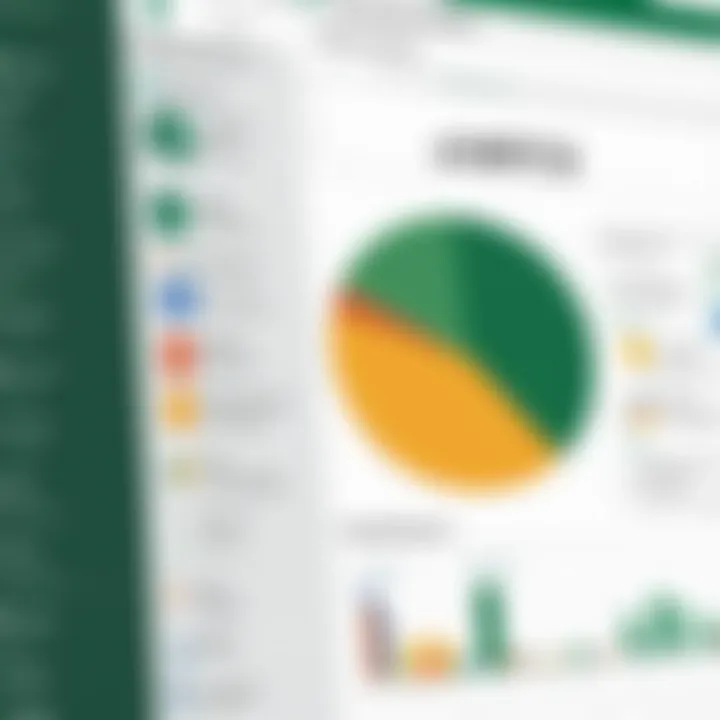Mastering Simple Macros for Enhanced Excel Efficiency


Intro
In the landscape of Excel, the use of macros stands out as a powerful tool, turning repetitive tasks into automated processes. Many users, whether students or professionals, may find themselves bogged down by time-consuming and mundane activities in their workflow. The tedious nature of these tasks often leads to frustration, prompting the need for solutions that can enhance productivity. This is where mastering simple macros becomes truly invaluable.
Diving into the realm of macros opens up a world of efficiency, offering users the opportunity to not just save time but also reduce the risk for error in data entry and repetitive calculations. But what exactly are these macros, and how do they fit into the broader context of Excel? The following sections will unfold an uncomplicated yet comprehensive guide on how to create, edit, and run macros, acting as a catalyst for improving your Excel acumen.
Moreover, understanding the nuances of macros will ensure users not only harness this functionality effectively but also safeguard their data by being aware of security measures. By the end of this article, readers will be equipped not only with the technical know-how but also with best practices that can vastly improve their automation skills, irrespective of their starting point.
In the coming sections, we will specifically highlight key concepts, practical applications, and hands-on examples designed to empower anyone looking to make their Excel experience seamless and more productive.
"The best way to predict the future is to create it." - Peter Drucker
With this in mind, let's begin our journey into the world of Excel Macros.
Understanding Macros
What is a Macro?
A macro in Excel is essentially a sequence of instructions or actions that can be recorded and played back. Think of it as your personal assistant, executing a series of tasks on your command without you having to lift a finger each time.
Why Use Macros?
The benefits of using macros are multifaceted. Here are a few key reasons:
- Efficiency: Automates repetitive tasks, saving valuable time.
- Accuracy: Reduces the likelihood of human error in data handling.
- Consistency: Ensures uniformity in tasks that need to be repeated, keeping results consistent across the board.
- Customization: Lets users tailor their Excel environment to fit their specific needs and preferences.
Getting Started with Excel Macros
Before jumping into creating macros, it’s essential to have a grasp of Excel’s interface and functionalities. Familiarize yourself with the Developer tab, which houses essential tools for macro creation. If it’s not visible in your ribbon, enabling it is the first step:
- Click on File.
- Navigate to Options.
- Select Customize Ribbon.
- Check the box for Developer and hit OK.
With the Developer tab at your disposal, you can now begin exploring the fascinating world of macros, smoothly transitioning from theory to practice.
In the next section, we will unravel the foundational concepts that govern the operation of macros, making sure you have a solid footing before diving deeper.
Stay tuned as we embark on this educational voyage!
Prolusion to Macros in Excel
Embarking on the journey of mastering macros in Excel opens up a world of possibilities for efficiency and automation. In today’s fast-paced environment, where time is of the essence, knowing how to harness the power of macros can significantly cut down repetitive tasks. Whether you’re a student trying to organize data or a professional aiming to streamline workflows, macros can be a game changer.
Understanding Macros
At their core, macros are a set of instructions that automate repetitive tasks in Excel. Think of macros as the shortcuts of the software. Instead of clicking through various menus and options repeatedly, you record a sequence of actions. Later, you can execute that entire sequence with just a click.
Imagine you’re regularly entering monthly expenses into a spreadsheet. Each month, it requires you to format the cells, apply formulas, and create charts. Recording a macro to perform these steps means you can complete the task in seconds instead of minutes. Understanding what macros are is the first step towards leveraging them effectively.
Advantages of Using Macros
The advantages of employing macros in your Excel tasks are extensive, and they merit careful consideration. Here are some key benefits:
- Time-Saving: The most apparent advantage. With a macro, you can dramatically reduce the time spent on routine tasks.
- Error Reduction: Manual entry or formatting often leads to mistakes. With macros, you’re executing the same steps consistently, minimizing potential errors.
- Increased Productivity: When you automate dull, repetitive tasks, you free up cognitive and creative resources for more important work.
- Customization: Macros can be tailored for specific tasks or workflows, making them versatile tools in any user's arsenal.
- Skill Development: Learning to use macros not only enhances your Excel skills but also familiarizes you with basic programming concepts, particularly Visual Basic for Applications (VBA).
"Automation allows you to focus on the ideas that matter."
In essence, understanding macros lays the foundation for a more efficient workflow in Excel. Tasks that once took hours can be executed in seconds with a little knowledge and practice. The journey into the world of macros not only serves immediate needs but also nurtures a mindset geared towards automation and efficiency.
Setting Up Excel for Macros
Getting Excel ready for using macros is akin to ensuring a smooth ride before hitting the road. Without the right setup, you might find yourself at a standstill or, worse, facing unexpected bumps along the way. This section emphasizes why setting up Excel is crucial, and it covers specific elements that facilitate smooth macro development. Key aspects include enabling the Developer Tab and adjusting Macro Security Settings, both of which pave the way for a fruitful experience in automating tasks.
Enabling the Developer Tab
For many who are just dipping their toes into the Excel macro waters, finding out how to tickle the Developer Tab into existence can feel like trying to locate a needle in a haystack. However, remember that this tab is your gateway to all things macro. Without it, you're stuck on the sidelines, unable to harness the full power of automation tools.
To enable the Developer Tab, follow these steps:
- Open Excel and click on ‘File’ in the upper-left corner.
- Select ‘Options’ from the menu.
- In the Excel Options dialog, click on the ‘Customize Ribbon’ tab.
- On the right side, you will see a list of main tabs. Check the box next to ‘Developer’.
- Click ‘OK’ to confirm.
Once you have the Developer Tab set up, you’ll notice it contains options for recording macros, accessing the Visual Basic for Applications (VBA) editor, and more. It’s almost like having a toolbox full of useful gadgets at your disposal.
Macro Security Settings


When diving into the world of macros, you can’t ignore the potential risks involved. Macro Security Settings act as your safety net, protecting you against malicious code that could compromise your data or system. As much as we want to automate mundane tasks, we don’t want to open the floodgates to every rogue macro out there.
Understanding and configuring these settings helps you find the right balance between flexibility and security. Here’s how to adjust the settings:
- With the Developer Tab active, click ‘Macro Security’, or you can find it under ‘Options’ in the File menu.
- You’ll see several security levels:
- Choose the level that suits your needs, ideally favoring security without closing the door on productivity.
- Disable all macros without notification: This is the most secure option. No macros will run at all.
- Disable all macros with notification: A balanced choice. If you opt for this, Excel will inform you when macros are present, letting you choose whether to enable them.
- Disable all macros except digitally signed macros: Good for when you trust certain sources, as it allows signed macros through.
- Enable all macros (not recommended): This opens the door wide but is a double-edged sword.
By establishing your Macro Security Settings, you’ll feel like you’ve fortified your castle while still enjoying the conveniences that come with automation.
"The road to efficiency is paved with well-set boundaries and informed choices."
Taking the time to set up the Developer Tab and fine-tune Security Settings equips you to step confidently into the realm of Excel macros. With these elements in play, you’re now ready to record your first macro in the next steps.
Creating Your First Simple Macro
Creating your first simple macro is a pivotal step in mastering Excel’s automation capabilities. Macros serve as your hands on the keyboard, performing repetitive tasks swiftly and efficiently. With macros in your toolkit, tasks that might take you forever can be completed in the blink of an eye. This allows you to focus on what truly matters: analyzing data and making informed decisions.
Recording a Macro
Recording a macro in Excel is like capturing a video of your actions. Once you hit that record button, every click, keystroke, and command is saved for future use. It’s straightforward:
- Open Excel and navigate to the Developer tab. If it’s not visible, you’ll need to enable it first.
- Click on Record Macro and enter a name for your macro. Be sure the name doesn’t have spaces or characters that could confuse Excel.
- Choose where to store your macro – This Workbook, New Workbook, or Personal Workbook. The last option is particularly useful if you want to use the macro across different files.
- Lastly, perform the tasks you want to automate. Once completed, click Stop Recording.
It is important to understand that the recorded macro will replicate exactly what you did. This means that if you made mistakes while recording, it will carry those errors into the macro.
Naming and Saving the Macro
When it comes to naming and saving your macro, a few best practices can make your life easier down the line. Choose a name that is both descriptive and clear, as it will help you understand its purpose when you’re browsing through your macros later. For instance, instead of naming your macro "Macro1," opt for something like "FormatInvoice" to clarify its function.
Once your macro is recorded, save your Excel workbook with a specific macro-enabled file extension. This is crucial; otherwise, your hard work could vanish like morning mist. Use either for macro-enabled workbooks or for binary workbooks. Forgetting to do this may leave you with an unresponsive macro, unable to perform its tasks when you re-open your workbook.
Remember: A well-structured naming system and sensible saving habits pave the way for a smoother macro-using experience.
In summary, creating your first simple macro is about recognizing the potential in mundane tasks and harnessing that through Excel's powerful tools. By recording and saving your macro properly, you set the stage for more advanced actions and greater efficiency in your daily workflow.
Understanding the Macro Editor
Navigating the VBA Editor
The VBA Editor might seem intimidating at first glance, but once you're familiar with its layout, you’ll find it isn’t too tricky. The editor is divided into various panels, each designed to assist in crafting your code.
- Project Explorer: This panel displays all the open workbooks and their corresponding components like worksheets and modules. Think of it as your map through a large library, where each shelf lists your available books (workbooks) and chapters (modules).
- Code Window: This is where the magic happens. Here you can write or edit your VBA code. Spend time practicing here, as you’ll become acquainted with the syntax and structure.
- Properties Window: Similar to a personal assistant, it helps you set or change the attributes of the selected object. Familiarize yourself with this window to streamline your coding process.
- Immediate Window: This is a nifty little section where you can test snippets of code without running a whole macro. Think of it as a quick test drive for your ideas.
To start navigating, simply open an Excel workbook, go to the Developer tab, click on "Visual Basic," and voila—you're inside the VBA Editor!
Basic Structure of a Macro
A macro in Excel is basically a set of instructions that tells the program what actions to perform. The structure of a macro is fairly straightforward but is powerful once you get the hang of it.
- Subroutine: Each macro begins with the keyword followed by the name of the macro. For example:This signals the beginning of the macro.
- Actions: Inside the subroutine, you'll include the actions that you want Excel to perform. This could range from formatting cells to pulling data from a database:This line places the text "Hello, World!" into cell A1.
- End Sub: Every macro must end with the line . This tells Excel that the instructions are complete.
Here is a complete example of a simple macro:
Understanding these elements is crucial because they serve as the building blocks for more complex macros.
Remember: Practice makes perfect! The more you play around with the VBA Editor and understand its structure, the more comfortable you’ll become with writing your own macros.
Editing Your Macro
Editing macros is a big deal in the world of Excel. Think of it like fine-tuning a musical instrument; every little tweak can enhance the final performance. Once you’ve recorded a macro, the fun doesn’t just stop there. Modifying the macro is where you really begin to see its potential come to life.
When you edit a macro using the VBA (Visual Basic for Applications) editor, you can add new functions, tweak existing behaviors, or completely overhaul its operations to better suit your needs. This kind of customization offers several benefits:
- Increased Efficiency: Adjusting the code allows you to optimize tasks that may need a little more pizzazz. You can remove unnecessary steps and make your macro how you want it tailored to your workflow.
- Error Reduction: Sometimes, when you record a macro, it captures stray actions, making your code a bit bloated. Editing helps clean up these blunders, ensuring everything runs smoothly.
- Enhanced Functionality: You can introduce loops, conditional statements, or even call other macros, giving your automation a lift. This flexibility makes macros versatile for a range of applications.


However, bear in mind a few things while editing. If you’re new to VBA, the codes might look like Greek at first. Don’t be disheartened; practice makes perfect. Additionally, code isn’t always linear; understanding how sections relate to one another is key to success.
Remember: A well-edited macro can save you precious time, making your tasks effortless.
Introducing VBA Code
VBA code is the blood that circulates through the veins of your macro. It brings it to life, drives its actions, and ultimately dictates how it behaves. Knowing a bit about the structure of VBA can make a world of difference.
In a simplified way, VBA consists of statements, methods, and properties. A statement is like a command or instruction; for example, makes Excel put "Hello" in cell A1. Methods are actions you can take—in this case, entering text. Properties refer to the characteristics of an object, like the color or font style.
Starting out, the best approach is to look at the recorded macro. You can do this by:
- Access the VBA Editor: Hit to bring up the editor.
- Double-click on the Module: Locate your recorded macro, which will typically be housed under the "Modules" section.
- Explore the Code: Familiarize yourself with the structure, like reading a new story—take it word by word and contextually.
Remember, it’s okay to play around. Make simple changes and observe what happens. This hands-on exploration will deepen your understanding of how VBA operates.
Common Tasks and Functions
Diving into VBA, you'll find plenty of common tasks and functions that often come in handy while editing your macros:
- Loops: These let you repeat actions. For instance, if you want to format cells in a range, a loop can help handle that efficiently.
- Conditional Statements: Using blocks, you can make decisions based on specific criteria, like checking if a cell is empty before adding data.
- Subroutines: These help break your code into manageble segments. When you notice a piece of your code repeating, throw it into a subroutine to keep things organized.
Here's a concise example of a basic loop:
This script checks if the cells in the range are not empty and makes the font bold if they contain data. Simple yet powerful.
When working with editing macros in Excel, keep an eye out for efficiency and clarity. A clean macro isn’t just easier to handle; it’s also easier for others (and future you) to understand and modify. So get in there and tweak away!
Running a Macro in Excel
In today’s fast-paced work environment, efficiency holds the key to excelling in any task. This is where running macros in Excel becomes essential, as it drastically cuts down the time spent on repetitive actions. Mastering this skill not only enhances your productivity but also gives you an edge in presenting data and automating mundane processes. From executing recorded macros to assigning them to buttons, learning how to harness the power of macros transforms the way you interact with your data.
Executing Recorded Macros
Executing a recorded macro is much like flipping a switch; once you’ve done the hard work of recording, running it is straightforward. First, make sure that your macro is stored in a location accessible to you—this could be in a personal macro workbook or the current workbook you are working on.
To run a macro, follow these steps:
- Access the Developer Tab: Click on the tab in the ribbon, which holds many of the tools you’ll use for macro management.
- Select Macros: Look for the button. This will bring up a dialog box listing all the macros you have created.
- Choose Your Macro: Select the macro you wish to execute and hit . Instantly, you will see the magic unfold!
Tip: For ease of access, consider assigning a shortcut key to your macro. This will allow you to execute it swiftly without clicking through menus.
Understanding this execution process solidifies your command over Excel, allowing you to focus more on data analysis than data entry. It’s a vital skill that turns what could take hours into mere minutes.
Assigning Macros to Buttons
Another great way to expedite your workflow is by assigning macros to buttons within your Excel sheet. It’s like giving your macro a friendly face, making it easily recognizable and clickable, thereby enhancing user interaction.
Here’s how to do it:
- Insert a Button: Go to the tab, and click on . From the drop-down, select the button icon, often labeled as . Now click on your worksheet where you want the button to appear.
- Assign a Macro: After placing the button, a dialog box will prompt you to assign a macro to it. Just select your desired macro from the list and hit .
- Customize Your Button: You can easily right-click on your new button to change its text or appearance for better visibility.
This approach not only cuts down the number of clicks required but also makes it user-friendly, especially for those who might not be familiar with navigating the macro menus. Furthermore, it effectively contributes to a clean interface, enabling anyone to execute the macros with ease.
Through these methods of executing and assigning macros, you pave the way for a more efficient working style in Excel. Embrace these practices, as they cater to both individuals managing their workload and teams looking for collaborative solutions. By doing so, Excel transforms from a mere spreadsheet tool to a comprehensive productivity powerhouse.
Troubleshooting Common Macro Issues
When you're diving into the world of macros in Excel, you'll inevitably stumble across a few hiccups. It's all part of the learning curve. Troubleshooting common macro issues is essential, as it not only helps you maintain your work efficiency but also enhances your understanding of how Excel operates under the hood. Let’s face it, there’s nothing more disheartening than a macro that simply won’t run when you need it to.
The significance of rectifying these issues can’t be overstated. A functional macro can save you countless hours and effort, while a malfunctioning one can lead to confusion, lost work, and even errors in critical reports. Learning how to troubleshoot will not only save you from such frustrations but also make you more confident as you advance in mastering macros.
Being aware of potential pitfalls and how to navigate through them is a huge advantage. It prepares you for unexpected challenges, leaving you equipped to face them head-on. Now, let’s break it down further with some practical tips and methods.
Debugging Tips
When a macro doesn’t perform as intended, debugging is the way to go. Here are some approaches to help you debug efficiently:
- Step Through Your Code: In the VBA Editor, you can run your macro line by line. This allows you to see exactly where things go sideways. You can do this by using F8 for stepping through. It’s somewhat like following a map; if you miss a turn, you can backtrack and see where you went wrong.
- Use Breakpoints: Setting breakpoints allows you to pause the execution of your macro at specific lines. Use the mouse to click on the left margin of the line where you want execution to pause. When you encounter issues, check variables and their values by hovering over them. This can shed light on unexpected behaviors.
- Add Debug.Print Statements: Sometimes, all you need to do is print out variable values to the Immediate Window. By inserting statements like within your code, you get live feedback on what’s happening as your macro runs.
"Debugging is like being the detective in a crime movie where you are also the murderer." - Anonymous


- Error Handling: Implement basic error handling using . This helps you to circumvent minor errors and lets you focus on bigger issues without the whole macro crashing at the first sign of trouble.
Handling Errors Gracefully
Errors are inevitable when working with macros, but how you handle them can make all the difference in creating a smooth user experience. Here are some thoughts on how to handle macro errors effectively:
- User-Friendly Error Messages: Instead of allowing a generic message to pop up and scare your user away, customize your error messages. For example, if a macro attempts to access a closed workbook, a friendly message like "Oops! It seems the workbook isn’t accessible right now. Please check if it’s open." is far more helpful.
- Routine Checks: Before running complex operations in a macro, always implement routine checks to ensure the prerequisites are met. For instance, check if specific sheets exist, or if files are accessible. This can prevent many errors from occurring in the first place.
- Graceful Exits: Use proper exit procedures in your VBA code. Having an or before error-handling routines ensures that your macro exits smoothly and doesn't leave resources hanging.
By developing skills to troubleshoot common issues and confront errors head-on, you lead yourself toward becoming a proficient user of Excel macros. Like learning to ride a bike, there might be bumps along the way, but with this knowledge and practice, you won’t just get by; you'll thrive.
Best Practices for Macro Development
When dabbling with macros in Excel, adhering to best practices can dramatically enhance not just the functionality of your macros but also the overall user experience. This section highlights crucial elements like code clarity and documentation. By embracing these practices, users can create robust macros that are easier to maintain and troubleshoot.
Keeping Your Code Clean
Keeping your code clean might sound like a simple task, but in reality, it's the bedrock of effective macro development. A well-structured macro is much more than just a line of code that executes a function; it’s about crafting something that’s readable and comprehensible. This becomes especially important when macros evolve over time. What might have started as a simple function can turn into a complex beast.
Here are some pointers to help maintain cleanliness in your code:
- Indentation: Just like spacing between sentences helps readability in writing, proper indentation in code does the same. Whenever you start a new logic block, use indentation to keep related lines together.
- Consistent Naming Conventions: Choose a naming style that makes sense. For instance, using camelCase or underscores can make variables and functions more readable. For example, instead of using vague names like or , opt for descriptive names like or . This will make it clear what each part of your code is doing.
- Avoiding Unused Code: Removing sections of code that aren’t in use not only declutters your macro but also prevents confusion down the road. Keep only the necessary lines that contribute to the functionality.
Taking the time to keep your code clean will mean that anyone revisiting the macro, including future you, will appreciate the effort.
"Good code is its own best documentation." - Steve McConnell
Documenting Your Macros
Documenting your macros is akin to writing a recipe for a unique dish. It allows others—and yourself later on—to understand why you chose certain steps or functions. Clear documentation helps streamline the process, especially in collaborative environments where multiple users might interact with the same macro.
Here’s how you can effectively document your macros:
- Commenting: This is your friend. Insert comments to explain what certain parts do. For instance, right before a loop, you might write: . This clarifies your reasoning behind the code's structure.
- Describing Functionality: At the beginning of your macro script, include a summary explaining what the macro does and how it works. This overview acts as a quick reference for anyone—and yourself—who reads the code later.
- Version History: Keep a log of changes made to your macros. This should include the date, the changes made, and the reason behind them. For example:
- 2023-03-10: Added error handling to check for empty cells before calculations.
- 2023-04-15: Optimized loop for better performance.
Failing to document your macros is akin to cooking a gourmet meal without writing down the recipe; you might make it once, but trying to recreate it would be a nightmare.
By integrating effective practices for cleanliness and documentation in your macro development, you're paving the way for smooth sailing in your Excel endeavors.
Security Considerations with Macros
When it comes to using macros in Excel, understanding the security considerations is paramount. A macro can save time and eliminate repetitive tasks, but it can also introduce vulnerabilities if not managed properly. The reality is that macros can be a double-edged sword. On one side, they offer a robust way to streamline tasks; on the other, they can serve as a gateway for malicious code.
For anyone learning programming or looking to maximize their efficiency in Excel, grasping these security concerns is essential. Here's a look at the specific elements to keep in mind:
Understanding Macro Security Risks
Macros have got a reputation for being a breeding ground for malicious software, often being termed as "Trojan horses" in the digital landscape. If one is not careful, enabling macros from unknown sources can lead to compromising sensitive information. Common risks include:
- Malware Infections: Malicious macros can install harmful software on your system.
- Data Corruption: An improperly designed macro could overwrite or corrupt your files or introduce inaccuracies.
- Confidentiality Issues: Sensitive data can be exposed if a macro is programmed to export or share information without your consent.
It's vital to understand that the risk escalates exponentially when macros are shared across networks. For example, if you download a workbook with a macro from the internet or receive one via email, you might unknowingly allow risky behavior onto your machine. Thus, it’s crucial to tread lightly and always scrutinize the source of your macro.
Safeguarding Your Workbooks
So, how does one mitigate these risks while still reaping the benefits of using macros? Here are practical strategies to safeguard your workbooks:
- Enable Macro Security Settings: Excel has built-in settings that allow you to control how macros are handled. Consider setting your Excel install to enable macros only from trusted sources.
- Regular Updates: Ensure your Excel and antivirus software are kept up-to-date. This can help better identify any potential threats.
- Use Digital Signatures: If you share your macros with others, consider digitally signing them. This process verifies the origin of the macro and assures users that it hasn't been tampered with.
- Backup Your Workbooks: Always maintain backups of your work. Regular backups can be a lifesaver in case of unintended overrides or if you need to revert to a previous version when something goes awry.
- Educate Yourself Regularly: The world of cybersecurity and macro use is ever-evolving. Keeping abreast of the latest threats and tool functionalities can empower you more effectively.
"Protection is better than remedy." This axiom aptly applies in the world of macros. Taking proactive measures ensures your Excel experience is not only efficient but also secure.
In summary, mastering macros isn’t just about learning how to use them effectively—it's about understanding the security implications they carry. By adhering to these considerations, you can enjoy the streamlined capabilities of macros while minimizing the associated risks.
Finale
As we draw this exploration of simple macros in Excel to a close, it’s worth taking a moment to reflect on the importnce of this powerful tool in enhancing productivity. Mastering macros isn’t just about learning a few commands; it’s about transforming the way you interact with your data. You’ll find that the more you engage with macros, the more streamlined your workflows become.
Reflecting on Macro Usage
In reflecting on the use of macros, it becomes clear that they aren't just a luxury; they're a necessity in environments where efficiency is key. Many tasks in Excel, such as data entry, formatting, or repetitive calculations, can be performed with a click of a button once macros are implemented. This automation frees up valuable time, allowing users to focus on higher-level analysis or decision-making.
Consider this: if an accountant has to input monthly data sheets by hand, the hours spent could easily add up. However, by creating a simple macro to automate data entry, that time could dwindle to mere minutes. Moreover, the human error associated with manual entries diminishes significantly. This leads to more accurate data handling while minimizing fatigue and other errors that come with repetitive tasks.
Encouragement for Further Learning
Don’t stop here—view this journey into macros as just the tip of the iceberg. The world of Excel, especially with macros, opens up avenues for much deeper understanding. Delving deeper into VBA (Visual Basic for Applications) offers a treasure trove of possibilities for customization and advanced functionalities. You can discover how to create more intricate macros that not only save time but elevate your analytical capabilities into new realms.
There are numerous resources available to guide your further exploration. Online courses, tutorials, and forums provide fantastic support. Websites like reddit.com or en.wikipedia.org can be excellent starting points for community interactions and additional learning.
The key takeaway is simple: embracing macros is a step toward working smarter—not necessarily harder. By continually honing these skills, you position yourself to maximize the full potential of Excel, ultimately paving the way for future opportunities in any analytical context.







